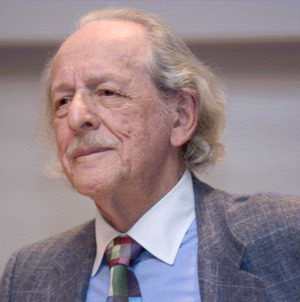Eugene Garfield facts for kids
Quick facts for kids
Eugene Garfield
|
|
|---|---|

Eugene Garfield at the Heritage Day awards in 2007
|
|
| Born |
Eugene Eli Garfinkle
September 16, 1925 New York City
|
| Died | February 26, 2017 (aged 91) Philadelphia, Pennsylvania
|
| Alma mater | |
| Known for |
|
| Awards |
|
| Scientific career | |
| Thesis | An algorithm for translating chemical names to molecular formulas (1961) |
Eugene Eli Garfield (born September 16, 1925 – died February 26, 2017) was an American expert in languages and a smart businessman. He was one of the people who helped create the fields of bibliometrics and scientometrics. These fields study how knowledge and science are organized and measured.
Garfield helped create important tools like Current Contents and the Science Citation Index (SCI). He also founded The Scientist magazine. His work changed how we find and understand scientific information.
Contents
Early Life and Education
Eugene Garfield was born in 1925 in New York City. His family came from Lithuania. He grew up in the East Bronx area of New York City.
He studied at the University of Colorado and University of California, Berkeley. In 1949, he earned a degree in chemistry from Columbia University. He also got a degree in Library Science from Columbia in 1953.
Later, he earned his PhD in Linguistics from the University of Pennsylvania in 1961. For his PhD, he created a special computer program. This program could translate chemical names into their chemical formulas.
Career and Research
After college, Garfield worked at Columbia University. He helped organize information about chemical compounds. This job made him realize he loved organizing information more than doing chemistry experiments.
In 1951, he started working at the Welch Medical Library. This library was at Johns Hopkins University in Baltimore. Many important information systems for the National Library of Medicine were developed there. He created ways to search and catalog information using punch-cards.
In 1956, Garfield started his own company. It was called the Institute for Scientific Information (ISI). ISI was located in Philadelphia, Pennsylvania. This company became very important for organizing scientific knowledge.
ISI created many new ways to find information. These included Current Contents and the Science Citation Index (SCI). They also made Journal Citation Reports and Index Chemicus. Garfield also started The Scientist, a magazine for scientists.
The Impact Factor
Eugene Garfield was inspired by an idea from Vannevar Bush. Bush wrote about how scientific ideas spread. Garfield wanted to create a way to track how scientific papers were connected. He called this a "citation index."
The Science Citation Index made it possible to calculate something called the impact factor. This number tries to show how important a scientific journal is. It measures how often articles in that journal are cited by other scientists.
Garfield found that a few journals, like Nature and Science, were very central to all of hard science. This means many other scientific papers referred to them.
Influence on Search Engines
Garfield's work on citation indexes was very important. It led to the development of other ways to find information. These include computer programs like the HITS algorithm and PageRank.
PageRank is the algorithm that powers the Google search engine. The people who started Google, Larry Page and Sergey Brin, have said that Eugene Garfield's ideas helped them create PageRank. Garfield wrote over 1,000 essays about his work.
Honors and Awards
Eugene Garfield received many awards for his important work.
- In 1984, he was given the John Price Wetherill Medal.
- He also received the Derek de Solla Price Memorial Medal in 1984.
- In 2007, he was given the Richard J. Bolte Sr. Award.
- He was also chosen to be a member of the American Philosophical Society in 2007.
There is even an award named after Garfield. It helps support students doing research in library and information science.
Different Views on Impact Factor
While the impact factor is widely used, not everyone agrees on how good it is. Some people think it's a helpful way to compare scientific journals. Others believe it can sometimes be misleading or not fully show the quality of research. They suggest that people should always read the actual scientific papers themselves.
Personal Life
Eugene Garfield passed away in 2017. He was survived by his wife, three sons, a daughter, two granddaughters, and two great-grandchildren. He had one daughter who passed away before him.
See also
 In Spanish: Eugene Garfield para niños
In Spanish: Eugene Garfield para niños

